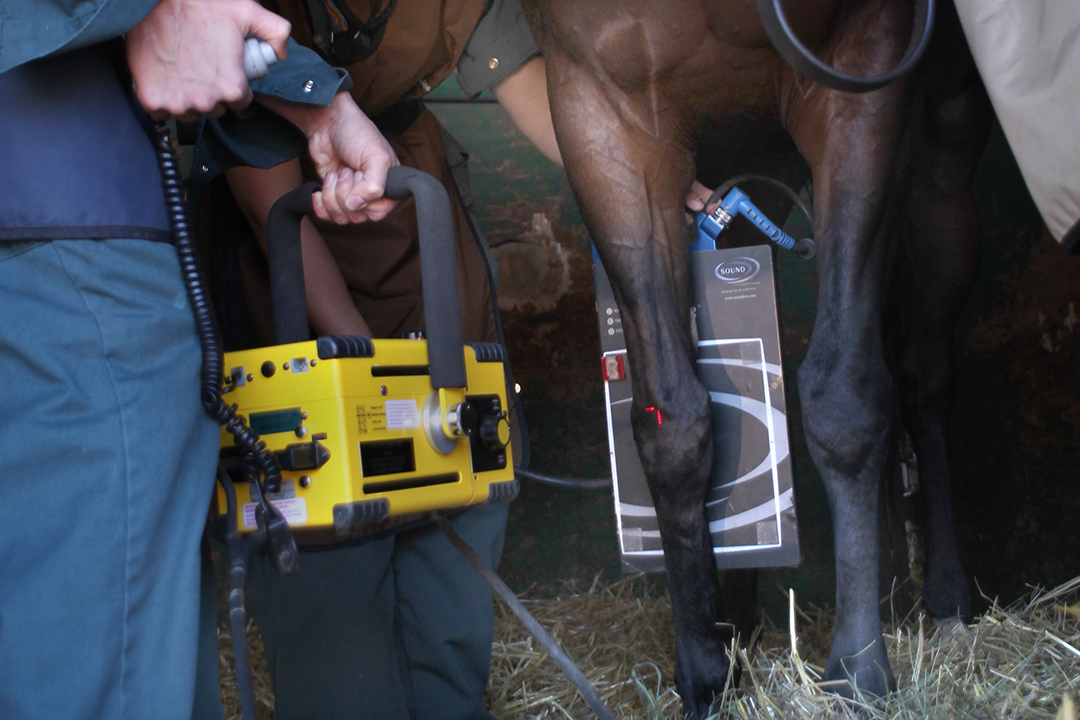
Safety vital near portable X-rays
A recent study by University of Saskatchewan (USask) researchers highlights the importance of regularly reviewing radiation safety practices for the use of portable X-ray machines in equine practice.
By Jessica ColbyThe study, which was published in the April 2021 issue of Canadian Veterinary Journal, surveyed three separate veterinary practices that use portable X-ray equipment and observed the clinics’ radiation safety practices.
Dr. Niels Koehncke, director of the Canadian Centre for Health and Safety in Agriculture at USask, led the research team that included two Western College of Veterinary Medicine (WCVM) researchers, Drs. Alexandra Belotta and Monique Mayer. The study’s goal was to determine if radiation safety practices needed to be addressed or improved upon among large animal veterinary clinical teams that treat equine patients.
The researchers found that clinical team members wore shielding aprons in over 99 per cent of examinations — but they weren’t as vigilant about glove use. Team members used gloves in just over half of all examinations observed, with registered veterinary technologists (RVTs) being more prone to wearing gloves in comparison to veterinarians.
Clinical staff used thyroid shields (lead collars) for 87 per cent of all examinations, but they wore protective eyeglasses for only 10 per cent of the imaging exams. Current safety regulations do not include protective eyeglass use, points out Belotta.
One participating clinic was the WCVM’s field service while the other two were private clinics. Belotta used a 360-degree camera to review behaviours in the field and to collect data.
“Radiation safety is very important in terms of trying to basically keep the occupational exposure as low as possible, reducing the likelihood of developing cancer,” says Belotta, a medical imaging resident in the WCVM’s Department of Small Animal Clinical Sciences.
Portable X-ray machines are invaluable tools in equine practice, allowing veterinarians and RVTs to take radiographs in the field and speeding up diagnosis of equine patients.
“It makes diagnosis much more readily available, so I think it’s incredibly helpful technology,” says Mayer, a professor in the WCVM’s Department of Small Animal Clinical Sciences.
“In the equine area, some workers do many consultations in the field so they can easily transport this X-ray equipment,” adds Belotta.
But these portable X-ray machines pose radiation risks and need to be handled with caution — just like other radiograph equipment.
“There is always a very low risk present of cancer, so any dose of radiation could theoretically lead to cancer,” says Mayer. “There are other risks that aren’t seen as often, but there’s also a risk of cataract formation. Those would be the two main risks that we currently guide our rules about doses.”
Study observations also showed that during most exams, clinical team members used their hands to hold the X-ray unit as well as the cassette — the component that’s placed behind the part of the patient being imaged.
“People not only hold the portable X-ray unit where the dose is fairly low, but they also hold the cassette, which is a little bit more of a concern because the beam is being directed at the cassette,” says Mayer.
The Canadian Veterinary Medical Association (CVMA) supports Health and Welfare Canada’s recommendation that veterinary workers use cassette holders in the area being radiographed. The portable X-ray units also come with a remote operator so clinical staff can stand away from the animal while imaging. However, Mayer adds that these cassette holders can become dangerous projectiles if horses kick them.
Oftentimes, veterinarians and RVTs are closer to the X-ray beam than recommended by federal guidelines. As a result, they are closer to the scattered radiation when the radiograph is taken.
“We actually looked at the doses to the workers,” says Mayer. “The doses are actually as we thought, quite low — except when people put their hand into the primary beam.”
Mayer adds that if a person’s hand or any other body part is included in the main X-ray beam, the radiation dose is much higher opposed to outside the beam. Whether the person is wearing gloves or not doesn’t matter — gloves are not designed to protect against exposure if the hand is in the primary beam.
“The biggest thing is to stay out of that primary beam,” says Mayer, adding that federal guidelines state that veterinary workers should be six feet away from the animal during an X-ray examination.
Both Belotta and Mayer agree that some radiation safety practices are likely overlooked due to veterinarians having multiple field calls to complete during the day. Mayer adds that with the physical risk of working with a horse, veterinarians may be trying to act quickly to keep themselves and others around them safe.
However, Mayer emphasizes that it’s important for people working with any form of ionizing radiation to be aware of the risk and to understand how to keep their dose as low as reasonably achievable.
“The whole approach to minimize risk is something called ALARA, or ‘as low as reasonably achievable,’” says Mayer, who has conducted similar radiation safety studies on small animal practices.
To help create more awareness, one of her graduate students created an instructional video on radiation safety in small animal clinics — a project that is now available online in four languages.
“I would love to see a similar video made for the equine field,” says Mayer.
Jessica Colby of Montmartre, Sask., is a University of Regina journalism student. She worked at the WCVM as a summer research communications intern in 2021.
